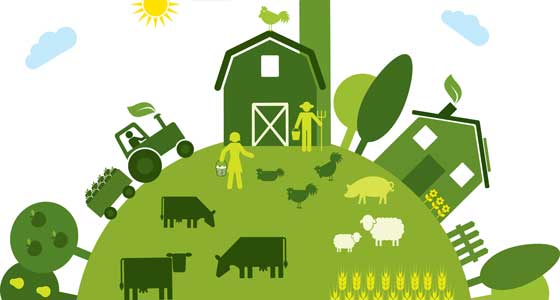News Highlight
Thermal stress seriously threatens sustainable livestock farming.
Key Takeaway
- Many regions in Kerala are experiencing a heatwave-like condition, with high temperatures and elusive summer rain, and livestock producers are fighting to safeguard their animals from thermal stress.
- Aside from the seasonal decrease in output, both small and large ruminants have several problems, including limited fertility and disease resistance capabilities.
- The Centre for Animal Adaptation to Environment and Climate Change Studies (CAADECCS) at Kerala Veterinary and Animal Sciences University (KVASU).
- It has begun a project to assess the impact of temperature stress on cattle.
- According to experts, productivity alone should not be used to pick cattle in light of climate change.
Thermal Stress and its Impact on Livestock
- About
- Thermal stress refers to animals’ physiological and metabolic responses to temperatures over their comfort zone.
- It occurs when an animal’s body cannot maintain its average internal temperature.
- It has several severe consequences for its health and productivity.
- Causes
- Many conditions, including high ambient temperature, humidity, solar radiation, and insufficient ventilation or cooling methods, can all contribute to thermal stress.
- It is a significant issue in cattle husbandry since it can have serious economic and animal welfare effects.
Impact of Thermal Stress
- Reduced Productivity
- Thermal stress can reduce milk output, decrease feed intake, and cause weight loss in livestock animals.
- Farmers’ production and income may suffer as a result.
- Health Issues
- It can cause various health problems in livestock animals, such as respiratory distress, heat stroke, and dehydration.
- This can result in greater susceptibility to diseases, decreased immunity, and a shorter lifespan.
- Economic Losses
- Thermal stress, health difficulties, and high mortality rates may cause significant economic losses for livestock farmers.
- Farmers may also have to pay extra to provide cooling systems for their livestock, such as fans or sprinklers.
- Environmental Impact
- To offset the impacts of thermal stress, farmers may have to resort to unsustainable practices such as;
- Excessive water use for cooling can harm the ecosystem.
- To offset the impacts of thermal stress, farmers may have to resort to unsustainable practices such as;
Status of the livestock sector in India
- India is the world’s largest milk producer and the third-largest egg producer.
- Around 200 million Indians live in cattle farming, with approximately 100 million dairy farmers.
- Approximately 80% of the country’s bovines are low in productivity and are raised by small and marginal farmers.
- Dairy is India’s single largest agricultural commodity.
How can Livestock be Prevented from Heat Stress?
- Breeding Management
- Cows exhibit fewer heat symptoms during heat stress.
- Hence an effective heat detection programme is required to discover cows with minimal heat symptoms.
- It is always preferable to continue artificial insemination breeding rather than employing bulls.
- Because both bulls and cows suffer infertility due to summer stress in natural breeding.
- Cooling Systems
- Fans with water sprinkling capabilities can be given, but excessive sprinkling should be avoided.
- Since it might result in moist bedding and make animals susceptible to mastitis and other infections.
- The farm should have adequate ventilation.
- Feeding Management
- Thermally stressed animals have reduced reproductive and productive performance.
- High-quality forages and balanced meals can help reduce the effects of heat stress and improve animal performance.
- Selection of Heat-Tolerant Animals
- By finding heat-tolerant animals, the genetic selection of animals is based on specific molecular genetic markers for heat tolerance.
- It can be beneficial to decrease heat stress in cattle and buffaloes.
National Livestock Mission (NLM)
- About
- The mission began in 2014-15 to promote the long-term development of the cattle sector.
- It promotes entrepreneurship and breed improvement by incentivising individual entrepreneurs, FPOs, farmer cooperatives, joint liability groups, SHGs, and other organisations.
- Since April 2019, it has been implemented as a sub-scheme of the White Revolution – Rashtriya Pashudhan Vikas Yojana.
- Sub–missions
- Sub -Mission on Livestock Development.
- Sub-Mission on Pig Development in North-Eastern Region.
- Sub-Mission on Feed and Fodder Development.
- Sub -Mission on Skill Development, Technology Transfer and Extension.
Rashtriya Gokul Mission
- It was founded in 2014 to conserve and develop indigenous breeds while improving their genetic makeup.
- The project is entirely grant-in-aid funded.
- The components include:
- Gokul Gramme is establishing integrated indigenous cattle centres.
- Gopalan Sangh is a breeder’s society that was established.
- Farmers receive the Gopal Ratna honour, while breeders’ associations receive the Kamadhenu award.
- National Kamdhenu Breeding Centres are becoming Centres of Excellence.
- Provision for capital subsidy up to Rs. 200 lakh for setting up a breeding farm with at least 200 milch cows/ buffalo using the latest breeding technology.

Way Forward
- As animal production systems expand, food protection must be linked and coordinated with state policies on nutrition, food security, poverty reduction, environmental health, and infrastructure development.
- Lack of coordination in expanding livestock production can have negative consequences, such as facilitating disease transmission among animals and from animals to humans.
- If public and environmental health rules are not implemented, the negative effects of animal production will worsen.
Pic Courtesy: IFT
Content Source: The Hindu



